

HISTORICAL BACKGROUND, 3RD BRIGADE, 4TH DIVISION, (THE BASTARD BRIGADE), 1966-67
by Bill Comeau, A Co - 1966-67
by Bill Comeau, A Co - 1966-67
How the unit received this unusual designation is an interesting footnote to a war that produced a number of ironic
circumstances. The unit earned this infamous title as soon as it arrived in Vietnam, but wait, I’m getting ahead of myself.
The story begins in December of 1965 in two different parts of the world. In Vietnam, General Westmoreland, commander
of allied forces in country looks at his maps of his theater of operations and realizes that Vietnam could be cut in two by the
enemy. The Central Highlands was the area of concern and he knew that in spite of a staunch defense by units of the 1st Air
Cavalry, the area was ripe for exploitation by the enemy. In fact, North Vietnam had also identified the Central Highlands as a
primary target and was moving to take advantage of the vulnerability of the zone. Westmoreland moved to bolster the defense
of this region by deploying the newly arriving 3rd Brigade of the 25th Division to Pleiku. That was where the unit remained for
the duration of its tour in Vietnam. When the two additional brigades of the 25th arrived in January to April 1966 they were
assigned to a forward base set up at Cu Chi. Once there, they were to serve as an interdiction for enemy units operating in the
area just north of Saigon who were routinely harassing Saigon and tying up South Vietnam troops in pursuit.
The story now moves stateside where thousands of inductees across the country are reporting for duty. At Fort Lewis,
Washington, the 4th Infantry Division, is receiving these raw recruits in order to bring its readiness up to combat level. In
October 1966 the Division is at a level of less than 30% strength. By January of 1966 division size is bolstered to 110%.
Training begins and intensifies over the next few months with the deliberate purpose of training the division to carry the fight to
the enemy in the Central Highlands later in the year. In late spring, with this assignment in mind, the Brigade is trucked to the
rugged mountains of the Cascadian Range for conditioning to the environment expected upon deployment in the war zone.
By July the first unit from the 4th Division arrived in Vietnam. This would be the lead element of the 2nd Brigade of the
Fourth, a unit of regimental strength. It was immediately sent to Pleiku. It was followed by additional units until the entire 1st and
2nd Brigade were in place there. This was completed by October 1966. Meanwhile the 3rd Brigade left Seattle by ship in mid-
September and arrived at Vung Tau on October 8th, 1966.
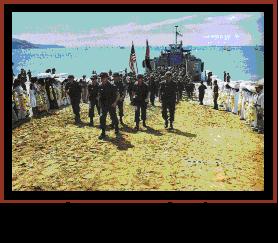
INTO THE BREACH, ARRIVAL IN VIETNAM
Upon landing, the unit was trucked to Bear Cat, a basecamp built by the 1st
Division a year earlier. They were now situated in the same general area of
operation as the 25th Division, just north of Saigon. At this point in time the 4th
was at Pleiku with a brigade of the 25th Division, while the 3rd Brigade of the
4th was in the south with the 25th Division. Both units came under operational
control of the larger division units. Both were to be stepchildren to their parent
Division until the situation was rectified in August of 1967. Yet the 3rd Brigade
of the 4th Division distinguished itself gallantly in a string of high profile
engagements with the enemy during this period.
1 A/2-12 of the third Brigade had the distinction of being one of the U.S.
Army units that marched in the annual National Day Parade in Saigon on
November 1st. This was not without it’s dangers, as the night before the
parade, two tons of explosives were discovered within the confines of the city,
presumably to be used by VC sappers to disrupt and discredit the regime.
The next day the parade went on like clock work until we heard the whoosh of
recoilless rifle rounds pass over us as we marched and landed two streets
away from us. The company never lost a step and proceeded to march past
the reviewing stand where Premier Nguyen Cao Ky and US Ambassador,
Henry Cabot Lodge stood symbolically side by side.
On November 2nd, a day after the parade and a month after landing, the
brigade assumed the defense of Phuoc Vihn, a base east of Saigon that the
1st Division had abandoned to pursue the enemy into the area known as War
Zone C. This operation was to be known as OPERATION ATTLEBORO and
was the first major probe into the Vietcong sanctuary known as War Zone C,
an area long exploited by the VC coming out of Cambodia for attacks in the
populous Tay Ninh Province. It was during this mission that a significant
amount of enemy activity was discovered operating out of the Michelin
Rubber Plantation near Dau Tieng. With the dry season coming on and
Westmoreland’s planned major offensive set to take place, it was decided to
move the Brigade to this area and establish a major base there that would be
named CAMP RAINIER, after the mountain in Washington, where the unit
formed before it’s deployment. This maneuver took place on November 26th,
1966
4th Division landing at Vung Tau
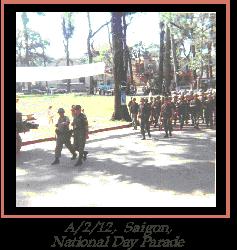
A 2/12th, Saigon, National Day Parade
Operation Attleboro and Cedar Falls
2 OPERATION ATTLEBORO was the largest U. S. Operation to date and was conducted by the 1st Division, 3rd Brigade of the 4th, 173rd Airborne Brigade, and several ARVN Battalions. Enemy casualties were confirmed at 1,106 dead. In addition, Americans had seized 2400 tons of rice, large ammunition caches with over 24,000 grenades, 600 mines, and 2,000 pounds of explosives; and destroyed 68 enemy base camps. Even more important, the operation served as a model for the more ambitious campaigns that were in the final planning stage
The next Operation, OPERATION CEDAR FALLS was an encirclement of the IRON TRIANGLE, North of Saigon. It was determined that the area should be neutralized before another venture into War Zone C. To accomplish this, it was decided to completely depopulate the Iron Triangle area and turn it into a Free Fire Zone. In particular, MACV was determined to destroy the village of Ben Suc, long a VC stronghold north of the Hobo Woods. After the village was secured, a captured VC platoon leader confirmed that no less than 4 companies operated out
2 OPERATION ATTLEBORO was the largest U. S. Operation to date and was conducted by the 1st Division, 3rd Brigade of the 4th, 173rd Airborne Brigade, and several ARVN Battalions. Enemy casualties were confirmed at 1,106 dead. In addition, Americans had seized 2400 tons of rice, large ammunition caches with over 24,000 grenades, 600 mines, and 2,000 pounds of explosives; and destroyed 68 enemy base camps. Even more important, the operation served as a model for the more ambitious campaigns that were in the final planning stage
The next Operation, OPERATION CEDAR FALLS was an encirclement of the IRON TRIANGLE, North of Saigon. It was determined that the area should be neutralized before another venture into War Zone C. To accomplish this, it was decided to completely depopulate the Iron Triangle area and turn it into a Free Fire Zone. In particular, MACV was determined to destroy the village of Ben Suc, long a VC stronghold north of the Hobo Woods. After the village was secured, a captured VC platoon leader confirmed that no less than 4 companies operated out
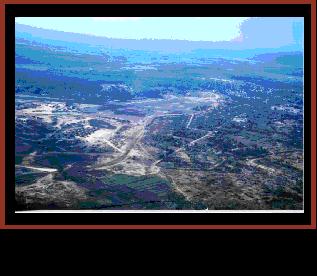
Operation Gadsden Prelude to the Big One
OPERATION GADSDEN followed on February 2nd. This would be a prelude to Operation JUNCTION CITY and was an
attempt to tempt the 9th VC Division into moving into War Zone C , where superior forces would be brought to bear in them later.
The 3rd Brigade of the 4th and the 196th Light Infantry Brigade were assigned to enter AREA 354 or western War Zone C and
search for the 271st Regiment and engage it. Preceded by B52 strikes, the 8 battalions seized two abandoned border villages Lo
Go and Xom Giua which served as enemy supply conduits from Cambodia. The operation had the added advantage of
interdicting the supply routes during the Tet Holiday, Feb 14th -18th denying their use for assaults into the populated areas to the
south.
Though the Operation was not successful in flushing out the 271st Regiment, the intelligence it was able to secure was
invaluable. The operation was able to confirm the presence of the 271st, 70th Guard, and the 680th Training Regiment in the Logo
Woods.
In addition, US Forces were able to capture nearly 300 tons of rice and smaller quantities of assorted military equipment. Death
count for the enemy was 160 killed at a cost of 29 American lives.
GADSDEN ended on February 21st and the 3rd Brigade was deployed in blocking positions along Highway 22, in preparation
for OPERATION JUNCTION CITY.
of the village. The village also had an extensive underground tunnel complex. The entire population of the village was evacuated, the tunnels filled with acetylene, and detonated, collapsing the network. All structures above ground were also leveled. Ben Suc was given up to the surrounding jungle and remained so for the duration of the war.
The 3rd Brigade of the 4th Division served as a support and diversionary force, working out of Dau Tieng during most of this campaign. Its mission was to fan out in company size formations and generally confuse the enemy into thinking a new probe into War Zone C was imminent. This allowed the units in the south to move without compromising their real intention.
During this campaign, on January 27, at an action that occurred near Tri Tam, A company, 2-12 of the Third Brigade stumbled into a reinforced bunker complex. The lead point man was immediately put down by small arms fire and a ferocious battle ensued. Spec 4 Donald Evans Jr., a Company Medic, braved enemy fire to administer life saving treatment to two downed soldiers, dragging a third to safety through a savage hail storm of enemy fire. Returning to treat additional fallen comrades, he was wounded by grenade fragments himself. In spite of his painful injuries he successfully evacuated another fallen comrade. Told to report to the rear, he refused and successfully moved another wounded person across another dangerous open area. He once more returned to the hostilities, where finally he was felled by small arms fire. Donald had made the supreme sacrifice and was awarded the first Medal Of Honor, posthumously, that the 4th Division earned in Vietnam.
CEDAR FALLS succeeded in killing over 700 insurgents, seizing 200 prisoners and 500 ralliers , making it the first operation in III Corps during which the enemy who surrendered equaled the number killed. Evacuating the Iron Triangle resulted in 5, 987 refugees who were relocated to Phu Cuong. Eventually, after 5 long months, they were moved to a government resettlement area ten kilometers to the south. The entire Iron Triangle now was vacant of civilians. Enemy equipment losses totaled 23 crew served weapons, 590 individual weapons, and over 2800 explosives such as mines, grenades, etc., 60,000 rounds of small arms ammunition and 7500 uniforms.
The 3rd Brigade of the 4th Division served as a support and diversionary force, working out of Dau Tieng during most of this campaign. Its mission was to fan out in company size formations and generally confuse the enemy into thinking a new probe into War Zone C was imminent. This allowed the units in the south to move without compromising their real intention.
During this campaign, on January 27, at an action that occurred near Tri Tam, A company, 2-12 of the Third Brigade stumbled into a reinforced bunker complex. The lead point man was immediately put down by small arms fire and a ferocious battle ensued. Spec 4 Donald Evans Jr., a Company Medic, braved enemy fire to administer life saving treatment to two downed soldiers, dragging a third to safety through a savage hail storm of enemy fire. Returning to treat additional fallen comrades, he was wounded by grenade fragments himself. In spite of his painful injuries he successfully evacuated another fallen comrade. Told to report to the rear, he refused and successfully moved another wounded person across another dangerous open area. He once more returned to the hostilities, where finally he was felled by small arms fire. Donald had made the supreme sacrifice and was awarded the first Medal Of Honor, posthumously, that the 4th Division earned in Vietnam.
CEDAR FALLS succeeded in killing over 700 insurgents, seizing 200 prisoners and 500 ralliers , making it the first operation in III Corps during which the enemy who surrendered equaled the number killed. Evacuating the Iron Triangle resulted in 5, 987 refugees who were relocated to Phu Cuong. Eventually, after 5 long months, they were moved to a government resettlement area ten kilometers to the south. The entire Iron Triangle now was vacant of civilians. Enemy equipment losses totaled 23 crew served weapons, 590 individual weapons, and over 2800 explosives such as mines, grenades, etc., 60,000 rounds of small arms ammunition and 7500 uniforms.
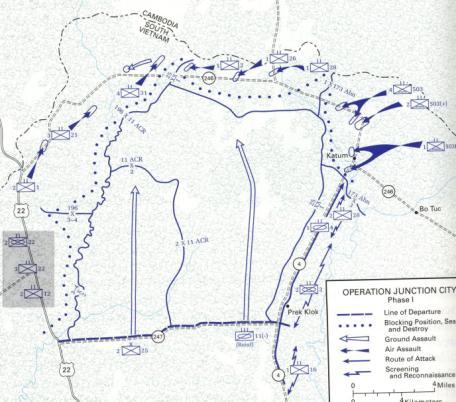
Operation Junction City
JUNCTION CITY was to be a gigantic encirclement of the of WAR ZONE C with the intent of trapping units operating in that
area and depriving them an exit into Cambodia. 3rd Brigade was in a blocking mode along Highway 22, (see shaded area)
while other units would sweep the enemy into them. Twenty-two battalions were utilized as the attacking force. Seventeen
artillery battalions and over 4000 Air Force sorties provided support for the expedition. The layout of the assault resembled a
gigantic horseshoe.
With the Third Brigade in place along Highway 22 on the morning of Feb. 22nd, the aerial fireworks began within the
horseshoe by a devastating B52 assault. I can personally remember that morning when the bombs fell. We were warned in
advance that the B52’s would be attacking and the area of attack would be close by. We were told that it would be the closest
that the B52’s had ever dropped their payload near an American ground force. They weren’t kidding as evidenced by the
ground troops on the ground. When the first bomb went off in the series, we joked by grabbing hold of nearby trees to steady
us, but it was a terrifying experience to feel the ground shake so violently. We prayed that those bombardiers had us properly
plotted. In ten minutes or so the air assault was over and the incursion of the ground troops began. In addition to the
helicopter troop deployment, the 173rd Airborne Brigade undertook what would be the only parachute assault of the entire
Vietnam War in the northeast sector of the horseshoe.
By 1800 hours all units were in position, with little enemy activity observed. The next morning, the assault units moved
into the horseshoe to engage the enemy trapped within it. Between the 22nd and 27th, the sweep produced little. Despite the
secrecy and tactical surprise of the assault, the main Central Office for South Vietnam(COSVN) headquarters still managed to
escape into Cambodia. Many enemy bases were discovered and destroyed within WAR ZONE C and later intelligence reports
indicated that COSVN did not appreciate the rude invasion of it’s domain and ordered it’s units to attack adjacent areas to
divert attention away from the main thrust area. A cat and mouse game continued for the next few days without any major
contact occurred until the 28th when a company from the 1st Division engaged a battalion from the 101st VC Regiment. The
firelight resulted in enemy losses of 167 dead at a cost of 25 dead Americans and 28 wounded.
By March 1st, frustrated at the lack of success,
the 25th Division moved it’s 1st and 2nd Brigades
back to Cu Chi and Tay Ninh, respectively. The
3rd Brigade was directed to remain along
Highway 22 as the 11th Armored Cavalry swept
towards them. They were not successful during
the next 10 days in engaging any major units of
the enemy. But that would change dramatically
during the following week. The Battle of Suoi Tre,
sometimes referred to as the attack on FIRE
SUPPORT BASE GOLD, was on the horizon. The
Third Brigade, 4th Division, would engage the
271st VC Main Force Regiment reinforced by two
additional battalions. A total of 2500 troops would
attack an isolated artillery battalion supported by
a battalion of infantry and the resulting carnage
would produce the largest enemy body count of
the war.
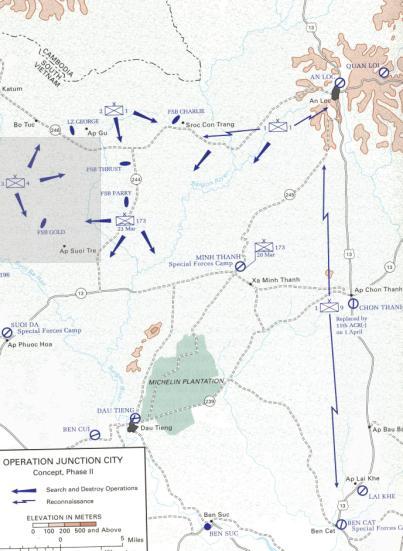
Operation Junction City,
Phase II
On March 15, the 3rd Brigade of the 4th
was ordered back to Dau Tieng and told to stand
down until Phase 2 of the Operation was begun.
Phase II of the Operation began on March 18th
when the commander of the Third Brigade, Col.
Marshall B. Garth, sent a mechanized force to a
clearing 25 kilometers north to a clearing where he
intended to secure with the armor and use as a
landing zone. The following morning he intended
to airlift the rest of his brigade to the secured
clearing and establish a large fire support
base there. The mechanized force failed to reach its objective due to a number of reasons and Garth was caught in a
dilemma. If he waited another day for the ‘mech’ to reach the appointed area he risked losing his element of surprise. If he
flew in the remainder of his Brigade in an unsecured area, he chanced sending his unit into a hot landing zone with no support
on the ground. He chose the latter, and on the 19th sent his troops into an alternate landing zone after a 30 minute artillery
barrage.
The first wave hit the clearing without incident but when the second lift hit the ground, a mine was detonated just as the
choppers were setting down. Two more explosions greeted the next company that arrived. The explosions destroyed 3
helicopters, killing 7 crewmen and 10 infantrymen. Colonel Garth was in a situation that he couldn’t escape from easily. He
already had too many men on the ground to call off the assault so he was forced to continue the deployment. I was in a
chopper heading to the LZ when the second mine went off. My Company Commander, Captain Allyn Palmer was on board
with me. I can clearly remember the chopper pilot turning to him and briefing him on the conditions that were being played out
on the ground. I turned to the others in the chopper, knowing what lay in wait for us and wondered if our luck would run out. It
hadn’t and we arrived along with the rest of the brigade without further incident.
The possibility of further danger was evident when the LZ was further searched for mines and 21 additional unexploded
mines were uncovered. Why the mines were never set off is anyone’s guess. At last the LZ was cleared. In spite of the fact
that the enemy was very well prepared for our assault on the clearing, Col. Garth decided to build his support base right on the
landing site. The fire support base was named ‘GOLD’.
FIRE SUPPORT BASE GOLD was completely in place by the evening of March 20th and manned by approximately 450
men from the 3-22nd Infantry minus 1 Company, and 2/77 Artillery. The rest of the brigade moved out and established
defensive positions. The 2-12 Infantry to the northwest and the 2-22 Mechanized were to the west separated from the firebase
by a stream( see map on page 6). That evening orders were sent to these forces to sweep to the north and west searching for
a 40 man enemy unit that Garth had observed from his helicopter. That evening went quietly for the units except for a report of
heavy movement along ‘Gold's’ position by listening posts just outside the firebase. In spite of the report of these activities just
outside ‘GOLD’, nothing transpired during the darkness. As dawn neared and no attack took place, a sense of relief took hold
as VC units rarely attacked fortified positions in the daylight. This would be the exception, as a major assault would explode
around FIREBASE GOLD at daybreak.
The Battle Of Suoi Tre
At 0631, the mortar barrage began followed by
an all out assault by the 272nd Regiment. In
addition to ‘Gold artillery units, units from two
additional firebases laid down barrages. In their
attempt to take out the mortars that were
pounding FIREBASE GOLD, units from
supporting units began zeroing in on areas that
were earlier targeted as possible mortar sites in
the event of a major assault as had taken place
at ‘GOLD’. In one of the many tragedies of the
war, A/2-12, my unit, was sitting on top of one of
those areas, unbeknownst to the artillery unit
attempting to quell the shelling at ‘GOLD’.
A/2-12 was situated just in the woodlines in the
northwest corner of a clearing, some 3 kilometers
to the west of FIREBASE GOLD on that fateful
morning. The previous day our company had
spent the day looping around west of GOLD
where we seemed to be going out of our way to
be seen. We purposely walked directly through
the middle of clearings. I assumed this was to
sucker the 9th VC Division to mass for an attack
on the support base.
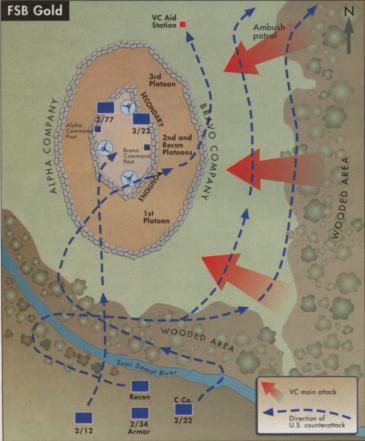
We had just awakened and Captain Palmer was receiving his orders for the day from the Battalion Commander. Some of the
troops had taken the time to fill in their foxholes. I hadn’t. We were situated on some land that was unusually easy to dig into
and we had a rather large hole that evening and we were in no rush to fill in. We heard the carnage that was taking place
somewhere to our East, and it became evident to us that FIRE SUPPORT BASE GOLD was coming under a major attack. I
believe that Palmer was interrupted in his transmission from Battalion HQ as the battle began. After a short time we heard in
the distance artillery being fired. Then we heard the whistle and the missiles went silent indicating to us that we were the
recipient of the barrage. Everyone reacted in different ways. Some jumped into their foxholes, others tried to redig theirs while
others tried to hide behind trees. Lieutenant Willenbring, the Artillery Forward Observer jumped into a foxhole with his RTO
and began trying to check the incoming fire. There were about 6 of us in my hole and I can remember a tense period during
which, approximately 25 rounds of artillery landed within our perimeter, then the firing stopped. There were several casualties
from this accident. One of the troops was killed as he frantically attempted to open up his filled foxhole. He was hit by flying
shrapnel from an airburst. The Company, now demoralized, gathered their wounded and dead and moved them to the clearing
where a chopper arrived and took them away. Then the race was on to reach the beleaguered ‘GOLD’ force. It wasn't until
years later we learned that we were sitting right on top of a pre-registered site that the artillery had targeted a day earlier in the
event "GOLD' came under rocket attack.
Meanwhile at FIRE SUPPORT BASE GOLD things were becoming frantic. They were still under a blistering mortar
barrage and a determined human wave attack. At 0655 Colonel Garth ordered the rest of the brigade to GOLD. A few minutes
later the VC force penetrated the perimeter. A sortie of jets stopped the advance but events were progressing rapidly out of
control. An additional strike targeted the eastern limit of the clearing but ended prematurely when enemy fire shot down the
Forward Air Controller who was directing that fire. At 0800, a wave of Vietcong broke through on the southeast quadrant,
targeting the artillery pieces. The artillerymen lowered their guns and volleyed beehive rounds right into this assault and
stopped it cold. Then the action switched to the northeast of the clearing where another major assault took place. Lt. Colonel
John A. Bender, the Regimental Commander of the 3-22nd, (the infantry unit protecting the firebase), ordered a fallback to
establish a new line of defense just in front of the artillery. He understood the importance of preventing the artillery from falling
into enemy hands. This move successfully defended the artillery position.
Luckily, just as this maneuver was taking place, a new Forward Air Controller arrived at the site along with several F-100
Super Sabres in tow. The Air Force liaison officer on the site, Major Bobby J. Meyer, noted that their were more than 500 of
the enemy heading right towards his position just as the jets arrived. He tells of how Napalm was dropped on this force and
they disappeared as if by magic. Events remained chaotic as VC Commanders were determined to keep the pressure on the
embattled artillerymen and their infantry support.
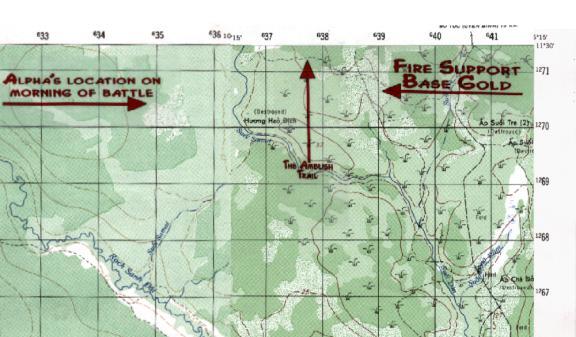
While this carnage was taking place at ‘GOLD’, other units were frantically crashing through the jungle desperately trying to reach the action. My Company, moved out smartly at 7:30 am after evacuating their dead and wounded from the earlier attack. As you can see from the above map, the battle took place due east of our position, but our way was obstructed by thick bamboo jungle. The enemy knew our position and assumed we would make a beeline to that trail just to the north, which ran directly into the battle clearing. Luckily, our Company Commander was wise enough to avoid trails and we hoofed it through the thick undergrowth. The decision saved the unit from an ambush that was set up along that northern trail. It was spotted from above and after Col. Garth was assured that we were 500 meters south of the booby trap, an aerial assault was initiated, destroying the waiting ambush site. We continued towards the rampage taking place to the east after crossing the Suoi Samat River.
To the south of the battle, the 2-22nd was bivouacked on the banks of a river. Viet Cong forces
had located the unit and reasoned the unit would be faced with a very formidable obstacle, namely that same Suoi Samat River, in any attempt to reinforce the Fire Base. That proved to be the case as at one point I overheard the Brigade Commander on the radio ordering the Mech unit to sink an APC and drive over it if it couldn't find a crossing site soon after several failed attempts at crossing. Luckily, the lead unit found a shallow point in the river and the order was never implemented. I spoke to Richard Ambler, an Artillery Forward Observer, attached to that column and he told me that the bamboo was so thick heading north to rescue the base, that the column was constantly losing lead vehicles to the jungle and required them to abandon the vehicle and move forward. He told me there was a trail of broken down APC's leading all the way up to GOLD.
In the meanwhile, things heated up at ‘GOLD’ again as the northern end of the perimeter was collapsing, allowing enemy forces to overrun a Quad Fifty machine gun and were preparing to turn it towards the Americans. An artillery unit using a high explosive charge took this out.
By 0900 hours the situation was still desperate but the perimeter was holding and reinforcements were about to lead a counter offensive. The VC were still not ready to disengage yet. By this time enemy soldiers that were advancing were seen wearing bandages from earlier wounds that had suffered earlier in the assault. Some were so badly wounded that they could not walk and were being carried piggyback into the attack by their comrades.
Alpha Company, 2-12th, was first to arrive at the western end of the clearing at 9:00 am.
They came out of the wood line shooting into the flank of the attacking VC. We were being prepared to reinforce the perimeter, when at 0912, C Company, 2-22nd burst though the southern end of the clearing. This unit would lead the charge, passing through the A/2-12 Infantry with the attached armor from the 2/34th. Some of the units raced up the right side of the VC to flank them and the rout was on. The armor pursued the escaping VC up to the northern end of the field until they were able to melt away into the jungle.
To the south of the battle, the 2-22nd was bivouacked on the banks of a river. Viet Cong forces
had located the unit and reasoned the unit would be faced with a very formidable obstacle, namely that same Suoi Samat River, in any attempt to reinforce the Fire Base. That proved to be the case as at one point I overheard the Brigade Commander on the radio ordering the Mech unit to sink an APC and drive over it if it couldn't find a crossing site soon after several failed attempts at crossing. Luckily, the lead unit found a shallow point in the river and the order was never implemented. I spoke to Richard Ambler, an Artillery Forward Observer, attached to that column and he told me that the bamboo was so thick heading north to rescue the base, that the column was constantly losing lead vehicles to the jungle and required them to abandon the vehicle and move forward. He told me there was a trail of broken down APC's leading all the way up to GOLD.
In the meanwhile, things heated up at ‘GOLD’ again as the northern end of the perimeter was collapsing, allowing enemy forces to overrun a Quad Fifty machine gun and were preparing to turn it towards the Americans. An artillery unit using a high explosive charge took this out.
By 0900 hours the situation was still desperate but the perimeter was holding and reinforcements were about to lead a counter offensive. The VC were still not ready to disengage yet. By this time enemy soldiers that were advancing were seen wearing bandages from earlier wounds that had suffered earlier in the assault. Some were so badly wounded that they could not walk and were being carried piggyback into the attack by their comrades.
Alpha Company, 2-12th, was first to arrive at the western end of the clearing at 9:00 am.
They came out of the wood line shooting into the flank of the attacking VC. We were being prepared to reinforce the perimeter, when at 0912, C Company, 2-22nd burst though the southern end of the clearing. This unit would lead the charge, passing through the A/2-12 Infantry with the attached armor from the 2/34th. Some of the units raced up the right side of the VC to flank them and the rout was on. The armor pursued the escaping VC up to the northern end of the field until they were able to melt away into the jungle.
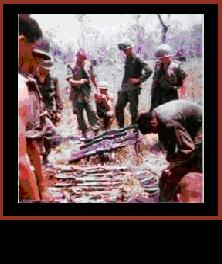

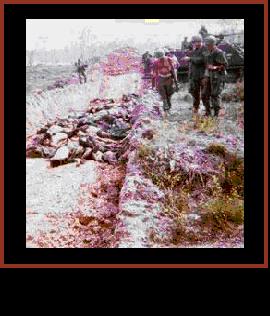
It was time to clean up. It became apparent what devastation took place that March morning. The 272ND VC Regiment was
decimated and could not reform into a fighting unit again for almost 9 months . This is when it would play a part in the attack on
Fire Support Base Burt, the second deadliest for the VC on the war. Then it was ravaged for a second time and for the remainder
of the war was manned by NVA soldiers coming in from the North instead of the local VC Cadre that manned it previously.
Enemy casualties of the 272nd VC Regiment were 647 killed and a bulldozer was sent in to plow a grave for the remains. 94
individual and 65 crew served weapons were captured that day. This was no haphazard attack. Everything needed for the attack
was waiting nearby for the trap to close. It was suspected that the VC goal was to overrun of a major American unit on the initial
day of meetings being held in the Philippines by allied leaders. President Johnson had assembled representatives from all the
allied forces fighting in South Vietnam to shore up support for the continuation of the war. If the attack on the base had been
successful it would have been a major embarrassment and political victory for the North. Instead it served notice to enemy
commanders that massing large forces against a superior force which could bring massive amounts of firepower to bear would be
very costly to his units.
American losses that mornings were 31 killed and 109 wounded. Enemy losses would prove to be the largest of any one-day
battle of the Vietnam Conflict and the 3rd Brigade, 4th Infantry would hold its place in history forever. All Third Brigade units
participating in the battle, including A/2-12, my Company, received the Presidential Unit Citation, the highest award authorized to
any armed forces unit in combat. Ironically, this same 272nd VC Regiment along with the 271st VC Regiment and the 3-22, 2-22.
2/77th Artillery of the third Brigade would once again be engaged in a major battle at Fire Support Base Burt on the evening of
Jan 2, 1968, 9 months later, less than 10 miles to the northeast. This would result in the second largest loss of the Vietnam War
for the Vietcong, 401 enemy dead. Oliver Stone, the Hollywood Director, was an infantryman in B3-22 when this battle took place
and he portrayed the attack in the climatic battle scene in the movie 'PLATOON'.
On the exact day of the big battle, changes took place that would break up the Brigade and restructure it somewhat. The
Brigade was almost exactly at the six month point since it had left Seattle and advanced maneuvering needed to begin to allow
the return of the troops at the end of their tour in an orderly fashion. It became apparent that the brigade would be deployed well
after the 12-month rotation began. If everyone left at the same time it would be impossible to maintain the strength of the unit. The
situation was even more critical with the 196th Light Infantry Brigade which had arrived in country in June, and needed to start
their rotation within a couple of months. For the 196th, the importance of maintaing unit level with experienced troops would be
underlined by the fact that the unit was being moved to Chu Lai, in the north to defend the I Corps area. It was expected that the
seasonal changes that were shifting the dry area to the north and rainy season to the south would mean enemy activity would
also shift their focus to that area and Westmoreland intended to meet the threat by beefing up the northern units. With all of that in
consideration, a number of front line troops from the 3rd Brigade were reassigned to the 196th on the very day of the Battle of
Suoi Tre. There were several from my company alone who I would lose contact with for decades until a recent reunion would fill in
the blanks of what had happened to them. At the time they had no idea that they were actually being shifted to an area where the
combat intensity would be maintained while in the south, the rainy season would make enemy activity lessen.
More changes were in store for the brigade upon the return to Dau Tieng on April 8th. The units would lose some of their
experienced officers to rear duty to allow the army to rotate their green officers into front line troops so they also would attain
combat experience. This ‘getting their ticket punched’ program was a source of poor morale in the units as the grunts had
established a rapport with their commanders that took time to earn. Some in the units had little confidence in new commanders,
who to them hadn’t earned the right to lead them. It didn’t help when some of these Lieutenants came on board with high
expectations and vigor, while the average grunt, worn down from months of jungle warfare, just wanted to do their jobs the best
they could, survive and go home. Even our Brigade Commander, Colonel Marshall B. Garth, was replaced by Colonel Kenneth E.
Buell during this transition.
After the clean up at FIRE SUPPORT BASE GOLD the Brigade conducted a sweep towards Dau Tieng looking for the
tattered remnants of the 272nd VC Battalion but as usual, the enemy had melted away into the jungle. As we conducted this
search south, our Company ran into rear guard action from the remnants of the battered 272nd Regiment. We heard several
locating shots from weapons that the enemy was using to locate lost members from their battered units. This march back to Dau
Tieng took until April 8th to complete. As for the enemy, they just vanished into the jungle, licking their wounds as they were
denied the victory they so wanted to humiliate the allied leaders meeting in the Philippines.
THE RAINY SEASON
I noted in my personal diary that I carried with me
during my tour that the first rain arrived on April 2nd at
DauTieng. When the rain came, it seemed to open a
new phase of operation in War Zone C. The enemy,
smarting from major losses that he suffered during the
last 6 months, broke down into smaller units and
remained that way emboldening the American forces
to do the same. This allowed the brigade to fan out
with many smaller units, covering a greater area to
gather intelligence and allow for Pacification to
accelerate.
When the 196th Infantry redeployed to Chu Lai,
becoming part of TASK FORCE OREGON, the 3rd
Brigade of the 4th Division assumed the defense of
Tay Ninh in addition to their Dau Tieng Base Camp.
This was a huge area of responsibility, encompassing
all of Tay Ninh Province and the western sector of
Bihn Duong Province.
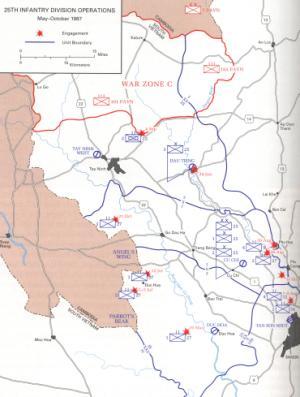
Part of the brigade moved to Tay Ninh West and from both these jump off points, it initiated a third sweep of the Zone, called
Junction City III on April 12th. By April 20th, when this phase ended, it became apparent that enemy activity had shifted away
from War Zone C, as little was seen of the VC insurgents.
On April 22nd, a new operation, called OPERATION MANHATTAN was taken on by the Brigade. Pacification was proceeding
rapidly, and MACV (U.S. Military Assistance Command, Vietnam) turned their attention to the security of Saigon. It was once
more time to pay a visit to the famous IRON TRIANGLE area just north of Saigon to determine if it had been resettled into after
the focus turned north to War Zone C. The Brigade swept south through this territory for three exhausting weeks. Little was
achieved during this probe except for small unit skirmishes that were bleeding companies with little to show for their pain.
It’s important to note that although enemy activity seemed to be down during this period, transitions were taking place, which
would introduce a new enemy force into the area. The 7th PAVN (People’s Army Of Vietnam), replacing the old 9th VC Division
was preparing to take on the 3rd Brigade as soon as it could muster of enough replacements. The 7th was initially used to bolster
other units that were decimated in earlier American sweeps. It was now gaining in size and would become a formidable foe for the
Brigade. The 7th Division contained two seasoned regiments in the 101st and the 141st Regiments.
The Brigade’s initial introduction to the 101st Regiment took place in June. That’s when a large cache of rice was found in
west Dau Tieng in an area OPERATION ATTLEBORO initiated its sweep. A guard captured at that site claimed he was told that a
new battalion was due to move into the area sometime later that month. Thus began a stake out of the site with ambush patrols.
A few days later a firefight broke out during which several North Vietnamese troops were killed. On their person were documents
that identified the unit moving in as the 2nd Battalion, 101st Regiment. This outfit was a recon unit that had been ordered to direct
a search of possible attacks on nearby installations. Their paperwork specifically targeted 3rd Brigade’s base at Dau Tieng.
It wouldn’t be long before this target was attacked. Two weeks later, on June 24th, over 80 mortars were fired into the Dau
Tieng Base Camp, damaging 27 helicopters and injuring 49 troops. This attack produced the catalyst for a new initiative that
would send a major American force deep into Tay Ninh Province. The code name for this exercise was OPERATION DIAMOND
HEAD. In addition to the mortar attack, there was additional intelligence gathered earlier in May that necessitated this response.
MACV had learned of COSVN’s intention of launching at least two new battalions into Tay Ninh Province in July.
Later intelligence had also determined that the enemy was shipping war material and ammunition to Svay Rieng, in Cambodia.
From there it was being transported across the border somewhere along the Angel’s Wing sector into an area just west of Cu Chi.
This added contraband needed to be intercepted before a strong offensive could be mounted against Saigon or Tay Ninh.
The initial maneuver to address the threat of war material making it’s way into Tay Ninh province would be the deployment of
two regiments from the third Brigade, the 2-12th and the 3-22nd, to be sent to the suspected area. The 2-22nd Mechanized
stayed behind at Dau Tieng to provide base security.
Before my Company would join the major push of OPERATION DIAMOND HEAD it was ordered into the Michelin Plantation
with Regional Forces to raid a village in that area. The plantation was laced with numerous villages and was a gold mine for
intelligence gathering. Later in the conflict there was a forced eviction of all those villages. There were just no way to control VC
activity originating there and so it was decided to vacate the hamlets.
The raid took place on June 27th, 3 days after the mortar attack on the base camp. I remember that day because something
unusual happened. This exact village was visited by my company when we first arrived in Dau Tieng in December and one of my
buddies had lost his automatic pistol there just outside the village. He had to pay for that lost weapon and got a harsh dress down
from the company commander. Well stranger than it seems possible, he checked in the nearby jungle outside that village that day
and actually recovered that pistol he lost 7 months earlier, less than two meters off of a well traveled path. At any rate, nothing
came of that raid other than scaring a few old men, ladies and children that occupied the hamlet. This was fairly typical in the
area. Only the frail and young were discovered living in the villages.
Contrary to the history books I used to research this piece, my personal diary specifically states OPERATION DIAMOND
HEAD began for my unit, the 2-12th, on June 28th. They indicated that the operation began on July 11th. I am not sure of the
reason for the discrepancy, but perhaps we were sent out earlier in preparation for the major assault.
On July 11th, the two Infantry Regiments entered the border region and began a futile search that came to a complete halt on
July 15th. On the night of the 14th a formidable sized unit from the VC 7th Division attacked and overran a government outpost
between Dau Tieng and Tay Ninh West. Colonel Buell immediately ordered his two Infantry Regiments to strike to the east as
quickly as possible. He had been concerned about a major move from the 7th VC Division, which he had been earlier warned
about, and thought that this could be the initial phase a of a serious assault to the densely populated cities he was responsible for.
Realizing that the Infantry Regiments would be slow reaching the threatened territory, Co. Buell ordered his reserve unit, the
2-22nd Mechanized, into the region to firm up the defense of the area that had been assaulted the evening before. The armor
was able to intercept two VC companies when it arrived, but upon discovery, the enemy disengaged and melted into the jungle. It
seemed that the enemy had no intention of engaging the Americans when they arrived. This strike, and retreat tactic was the
norm for this period. They would choose the time and location that suited them best.
There was speculation that the intelligence warning of a major attack on Tay Ninh West and the attack on the outpost was a
ploy to pull the two regiments out of the border areas so the supplies could be transported in unmolested.
In any event, these types of hit and run attacks were frustrating to the troops as it was bleeding the line companies without
producing any major engagements with the enemy. This was attested to by the casualty count that the 3rd Brigade had suffered
since the end of operation Junction City, which ended 3 months earlier. The actual enemy body count confirmed for that period
was 69 enemy dead, at a cost of 32 American troops by the end of August. This type of results continued more or less the same
through the end of October.

POSTSCRIPT
The American Heritage History of The English Language defines the word ‘Bastard’ as “illegitimate, irregular, inferior, or of
dubious origin.” From the moment the unit dropped anchor outside of Vung Tau, the Brigade was an attachment to a
unassociated Division. Circumstances were such that it was seemed that it would be subservient to the 25th Division and would
remain the stepchild of the Division. It wasn’t until early August that the 3rd Brigade was allowed to wear the colors of the 25th
Division, which it would ultimately do to this day. After reading the glorious way the old 3rd Brigade performed during this
transition period, I suspect that you will agree with me that the ‘Bastard Brigade’ was proudly welcomed into the 25th Division
and at last had found a home.
This historical collection was assembled primarily from a government archives and from personal collections obtained from
the men who were there. I would personally like to extend my gratitude for the help and encouragement I received from my wife,
Chris. In the month that I researched and assembled this work she saw me sparingly and never complained. I met a good one
when I came courting you. Last, but not least, I’d like to thank the buddies from my old unit, A/2-12 who helped me when my
memory failed me. To them I dedicate this history. You were the best then, the best now. We’re home.
Bill Comeau, RTO, A/2-12, 66-67
BIBLIOGRAPHY
Lieutenant General Bernard William Rogers. Vietnam Studies Cedar Falls- Junction City: A Turning Point, Dept. Of The
Army, Washington, D.C., 1989
George L. MacGarrigle, Combat Operations, Taking The Offense, October 1966 to October 1967, Center Of Military History,
U.S. Army Washington, D.C., 1998
Lieutenant Colonel Robert L. Hemphill, U.S. Army(retired), VC Onslaught at Fire Support Base Gold, Vietnam Magazine,
December, 1998
Edward Hymoff, Fourth Infantry Division in Vietnam,, 1967 yearbook, Turner Publishing
Captain Edmund C. Stone, Narrative for Presidential Unit Citation, Battle of Suoi Tre ( Fire Support Base GOLD), 2-12th
Archives, now in safekeeping of Alpha Association Archives, courtesy of First Sgt. Tsuzuki Kimura
The buddies from A/2-12 who pitched in for this account, Gary Barney, Ron Bergeron, George Hanna, Jim Deluco, Joe Kirkup,
Henry Osowiecki, and Porter Harvey. You guys kept my e-mail box stuffed with great material.
1 Parade Photo Source, Author, personal collection
2 Aerial photo taken by Jim Deluco, personal collection
3 All photos taken at Fire Support Base Gold shot by Wilbur Dahlke, an F. O. at the battle site. Thanks to Richard Ambler, and
George Hanna for their help in acquiring the use of these shots
Dau Tieng - Aerial View, January 1967


Captured weapons Enemy equipment collection Final resting place
PDF Documents of interest
Be patient - Needs to download
Be patient - Needs to download



